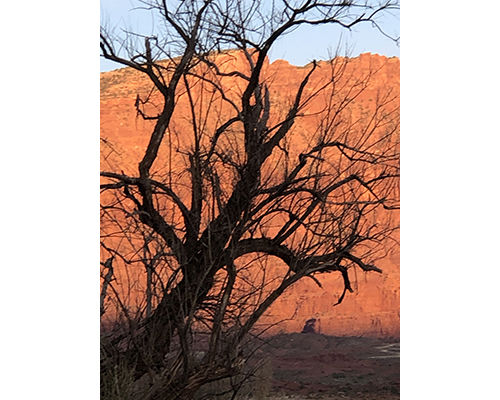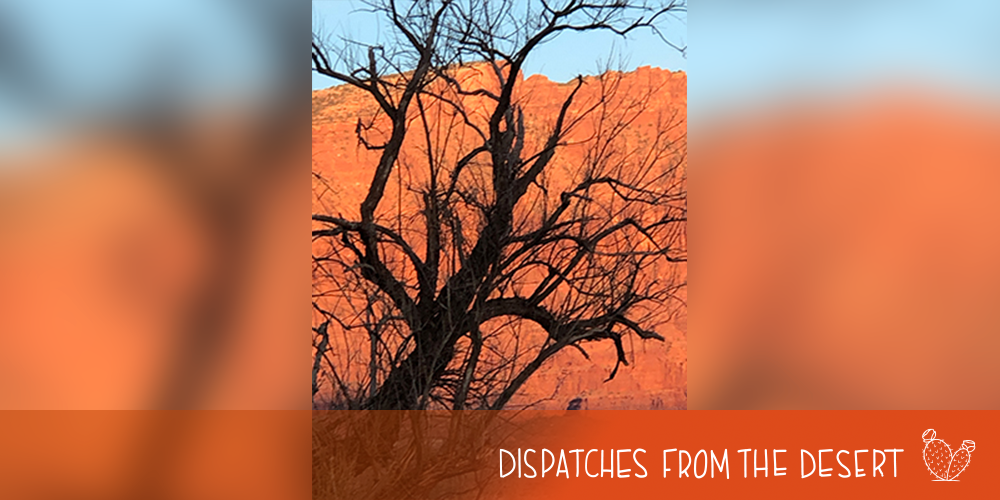Finding Beauty in a Broken World

This article is part of the "Dispatches from the Desert: Finding Beauty in a Broken World" series developed by Terry Tempest Williams as a gift for U of U Health caregivers during the Covid-19 pandemic.
31 March 2020
Castle Valley, Utah
ow strange, this quieting, this pause around the planet, most of us around the globe now at home as a result of the COVID-19 pandemic. I returned home from Cambridge, Massachusetts to Utah on March 11 and immediately, went into self-quarantine for fourteen days.
I walked. I walked with Beauty holding one hand and Terror holding the other. I thought about the coronavirus – of Earth; I thought about our species – of Earth; no separation. It is not something outside us, but inside us. What brings us together is breath.
Shortness of breath is a symptom. We are holding our breaths as the numbers of cases rise and deaths in New York City, we are told. Now one every four minutes. We have exceeded China’s casualty count. Death is life. Life is death. We are dying.
How do we face the unseen, the unsaid and the unknown, this certainty of death that feels uncertain?
We are home. My mother died at home. My brothers died at home. Most of my grandparents died at home. There is grace in dying in one’s own home with loved ones near.
But now we are being asked to die away from home, away from our loved ones and families. The doctors and nurses are now not only treating the living but the dying. You are asked to be the beloved ones caring for and attending to the dead.
How to share this burden and responsibility and blessing?
Of Earth. No separation. The virus is us. We are the virus. We are one. We are all each other’s keepers now. Instead of being fearful of exposure — (dwelling on who has the virus and who does not, a negative or positive mindset) — what if we embrace the idea of exposure in a deeper way? What if we expose the possibility that we can both hold the physical reality of what is required — social distance, tests, scientific protocols, medicines, equipment, masks, gowns, and vaccines — alongside, the spiritual understanding of what is necessary.
We are all each other’s keepers now.
We the people while at home can hold the peace, strength and stamina for the doctors and nurses on the front lines; and the people who are working in the warehouses, grocery stores, food services, and post offices, so we can go on living. Can we come to see the health providers in our hospitals, tents, ships and clinics as family members — tending to our loved ones called patients, struggling to breathe, and know they are being met with both the urgency and patience of our collective care. We are all health providers now, physical health care workers and spiritual health care providers working hand in hand.
By dissolving the boundaries of our former selves and becoming our expanded selves we become nimble, capable of shape shifting into the realm of the Unseen which is where coronavirus lives.
The Unseen is our new shared dwelling place.

Last week on the Spring Equinox, Victor Masayesva, a friend and Hopi filmmaker shared his thoughts on the coronavirus and the Unseen:
The sun is returning to the Spring equinox and ancestral dreams of preparing the seeds for planting along with constant: will the rains come?
In these days I find myself responding to friends worried about the COVID-19, with the offering: This is the unseen world that is referred to as “qatymakam”, the unseen, that is now manifesting, the unseen world that is so affective, and only not seen because of our anthropocentric, limited perceptions of what is real and alive…the vast unknown connections and interdependencies that we are barely conscious about, but about which the current conditions have awoken us to...
We are not alone. The unseen are also present. We have to be humble in the presence of the unseen as well as the living and active beings, because we depend upon each other…With this it is worth reflecting on the nature, scale, scope of compassion and all our relations. When the seeds and our prayers are put into the earth the reluctant rains will also be present so compassion will be required. When we have moved on, safe, keep a reminder of what these days were like. Pai Lolma, Paz, Peace.
What if our embrace of the Unseen could offer us a new of vision of how interconnected we are regardless of time and space? Boundaries become fluid not fixed. What if our acknowledgement of the Unseen could temper our fears and reimagine the world?
Distance becomes presence. When we practice “social distance” separated of others by the recommended six feet — what if we recognized the open space between us as the presence of compassion, the presence of those we love who stand among us filling that space, unseen, but not unfelt? This space of distance could also become the space of those in need, the space of those who are on the front lines who are healing the sick and dying, those on the domestic front lines serving the living with all we need to stay home to stay the terror. Our social distancing then becomes a gesture of making room for those who are not physically with us but spiritually present with us — side by side — we are one.
On each walk I take in the desert among piñon and juniper and sage, I am accompanied by my shadow. Sometimes it walks ahead of me, sometimes it walks behind me, and on other occasions I walk unaware of it at all. Death is our shadow. We are walking in shadow and light. What remains unseen, unsaid, and unknown is what we are called to see, to hear, and greet together – as we are all – of Earth.
Terry Tempest Williams
There’s a compassion wall—a barrier created by the extra precautions COVID-19 requires. Harvard Graduate School of Education student Niharika Sanyal reflects on the pain of the provider, the patient, and the loved ones across the world struck by the pandemic.
Harvard Graduate School of Education student Niharika Sanyal shares a simple story with a powerful message of hope and universal connection.
Terry Tempest Williams is a writer, naturalist, activist, educator—and patient. As our workforce prepares to care for more patients, she asked her physician, Dr. Tom Miller, to put her to work. In this first “Dispatch from the Desert,” Terry offers solace by way of a brief transport to Castle Valley, Utah.
